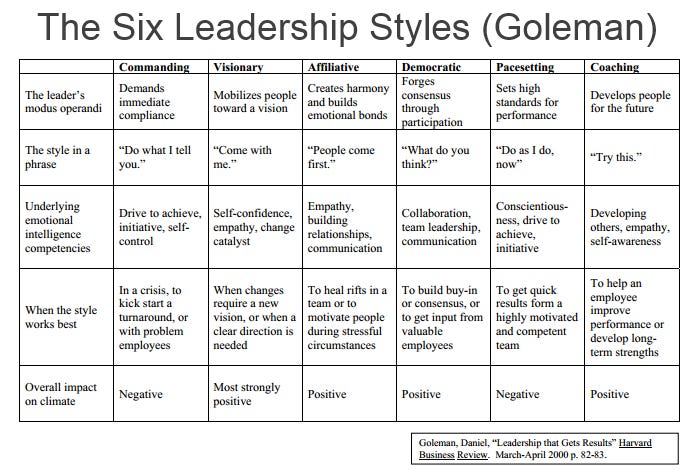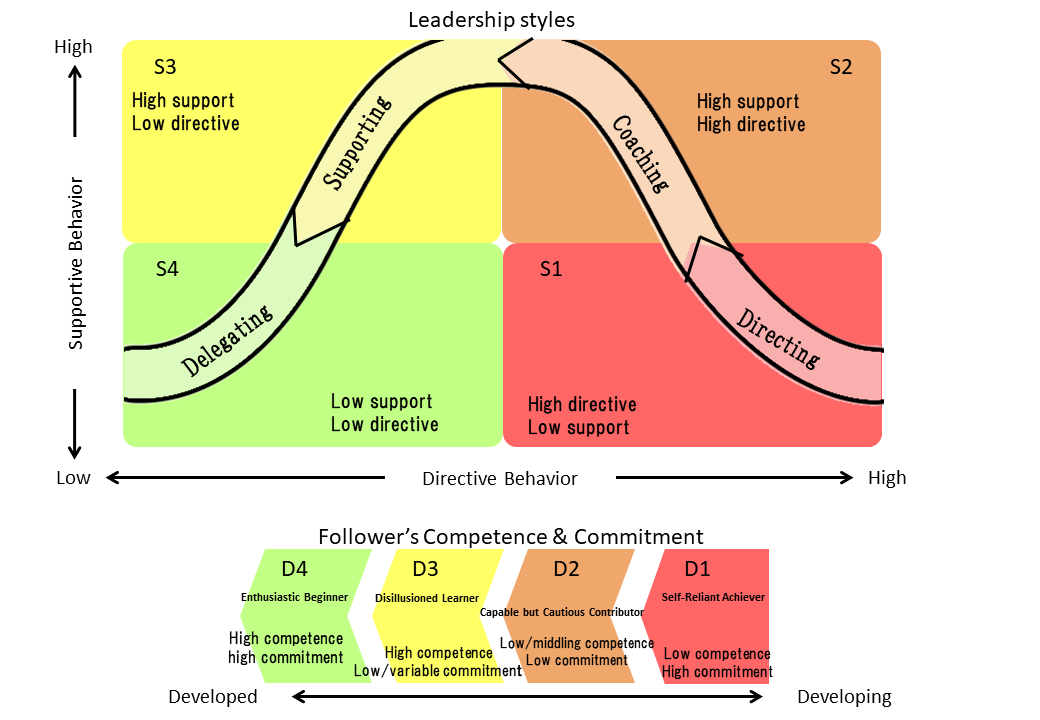This post was originally included in the 24th issue of my weekly newsletter. If you find it interesting, maybe you’d be interested in subscribing.
If you were asked which leadership style was the best, what would you answer?
I already looked for an answer to this question in a post about leadership styles months ago. And this was one of the multiple questions that my coach asked me in my previous session with him.
The answer wasn’t one of them, but all. The trick is that we may adapt our leadership based on the situation and the people we have.
This question was the preparation for a knowledge pill based on Situational Leadership, an adaptive leadership style that identifies a leadership style based on the person’s maturity or development.
But this is not only about having the flexibility to adapt our leadership style. Knowing our team, and showing the proper skills based on its maturity, imply that our success as managers is linked to our ability to coach our teams.
Leading as a Coach
And this is the main topic from The Leader as a Coach. In this article, Herminia Ibarra and Anne Scoular wrote about the twenty-first-century managers that simply don’t (and can’t!) have all the right answers. Being a manager is a role that is becoming like a coach.
But what means being a coach? Mainly, it is about engaging in with all their people all the time, in ways that help define the organization’s culture and advance its mission. As a coach, we need to help ensure that the people move forward aligned with the cultural values and the mission.
And how could we do it? In general, we could ask questions instead of providing answers, support employees instead of judging them, and facilitate their development instead of dictating what has to be done. It will always depend on what is needed in a given situation with any single person. There will be moments where dictating will be required, and so asking questions.
It doesn’t seem complicated, but it is, and it’s also a huge shift. Management is usually unenthusiastic about coaching, and studies have shown that people usually think they are good at it, but they don’t.
A classical case of study at executive training is to play the role of a manager who must decide whether to fire or coach a direct report that is not performing up to par. Nine of ten decide to coach. We all know the answer, even when we don’t lead by example.
But when it comes time to play, people demonstrate much room for improvement. People know what they’re supposed to do, but it doesn’t come naturally because they aren’t used to it.
Styles of Coaching
In the same article, Herminia and Anne presented the following 2×2 axis with one axis showing the information, advice, or expertise that a coach puts into the relationship with the person being coached, and the other showing the motivational energy that a coach pulls out by unlocking that person’s own insights and solutions.

- Directive coaching: This is mentoring. It needs more telling than asking.
- Laissez-faire coaching: Probably anti-coaching, when everybody knows what to do, and the best way is to leave them alone doing
- Non-directive coaching: This means listening and questioning. The coach is a facilitator and helps with problem-solving.
- Situational coaching: A combination of others. This is where all the coaches should aspire to arrive, striking a fine balance between directive and non-directive styles according to the moment’s specific needs.
The article also introduces other interesting points, like the GROW coaching model, especially for non-directive coaching. I encourage you to read it.
Situational Leadership
Returning to the original topic, situational leadership strategy encourages leaders to take stock of their team members, weigh the many variables in their workplace, and choose the leadership style that best fits their goals and circumstances.
There isn’t a uniform leadership style that works for everyone all the time. You may need to adjust your style based on the people you’re managing, the context in which you’re leading, or the external pressures you’re under.
According to STU university, there are two models for Situational or Adaptative Leadership, the one described by Daniel Goleman and another by Ken Blanchard and Paul Hershey.
In this newsletter, I am going to focus on the second. I also mentioned Goleman’s in my blog post. You could find below a summary of the Six leadership Styles he proposed.

The Situational Leadership Model has two fundamental concepts: leadership style and the individual or group’s performance readiness level, also referred to as maturity level or development level.
The Maturity
There are two variables to consider when measuring Maturity: ability and willingness. Ability is related to our capacity to do a task, and willingness has to do with attitude.
There are two characteristics to consider also when measuring Maturity:
- It is relative: one person can be mature regarding a concrete task, but not to others.
- It is dynamic: It is measured on a concrete moment, that can’t be different on the following.
Based on the ability/willingness, they identified four levels of Maturity (M1 to M4).

Leadership Styles
Do you remember the 2×2 matrix that presented Herminia and Anne regarding coaching styles? Well, regarding leadership, it is a similar case. We found two different approaches, task or relationship-oriented, directive or nondirective, more controller or developer.
- Telling: Leader makes decisions, one-way communication, with specific guidance, and close supervision. Related to M1.
- Selling: The leader is open to cooperation and suggestion but more focused on explaining and persuading. Related to M2.
- Participating: Participating but leaving decisions to the people. Sharing and facilitating, fostering creativity. Related to M3.
- Delegating: Letting others do, providing minimum guidance to workers, or help to solve problems. They may be asked from time to time to help with decision-making. Related to M4.
Evolution of the Model
Blanchard and Hershey evolved the model differently, bringing new models. Blanchard’s situational leadership II model uses the terms “competence” (ability, knowledge, and skill) and “commitment” (confidence and motivation) to describe different levels of development.
According to Ken Blanchard, four combinations of competence and commitment make up what we call development level.
Find below Blanchard’s Situational Leadership Model II based on competence and commitment.

You’ll find slight differences in the leadership naming, and maturity is related to the development.
- Telling evolves to Directing, and M1 is becoming D1. The leader makes decisions and has close supervision. The goal is to help to learn.
- Selling evolves to Coaching, and M2 becomes D2. The leader continues making decisions but is open to suggestions and explains the reasons. The goal is to help grow and gain confidence.
- Participating evolves to Coaching, and M3 becomes D3. The leader gives support, and less direction, helping the report to reach its own solutions. The goal is to help growing confidence and motivation.
- Delegating remains the same, and M4 becomes D4. The leader gives resources, shares authority but remains responsible. The goal is to help reach other levels to continue growing.
You will find a more detailed explanation of each group’s behavior and development in the post How Practicing Situational Leadership Can Change Your Team’s Dynamic.
Final Considerations
I am pretty sure that while reading this, you were able to identify if a person could fit into any M or D categorization. Probably you find that this theory makes sense, or it is common sense.
If not, try to think about it. Analyze which maturity or development level applies to each person of your team or group, and which leadership style fits his current level and situation. And be aware of the differences between each.
Before ending, two final considerations:
- Remember that no leadership style fits all situations, people, or environments.
- The leader must be able to adapt leadership to each situation and person.
I hope you liked it. If so, please share it! Do not hesitate to add your comments. And, if you want to stay up to date, don’t miss my free newsletter, where this post began.
As always, thanks for reading.
Also published on Medium.
Join the FREE Newsletter
Also published on Medium.


